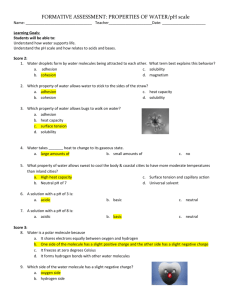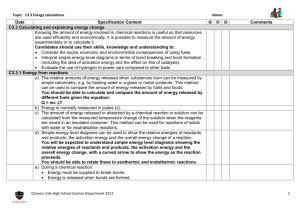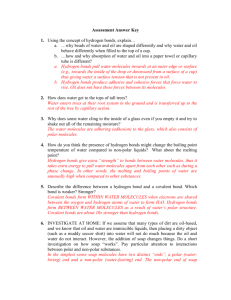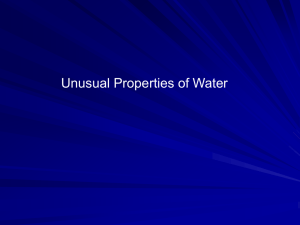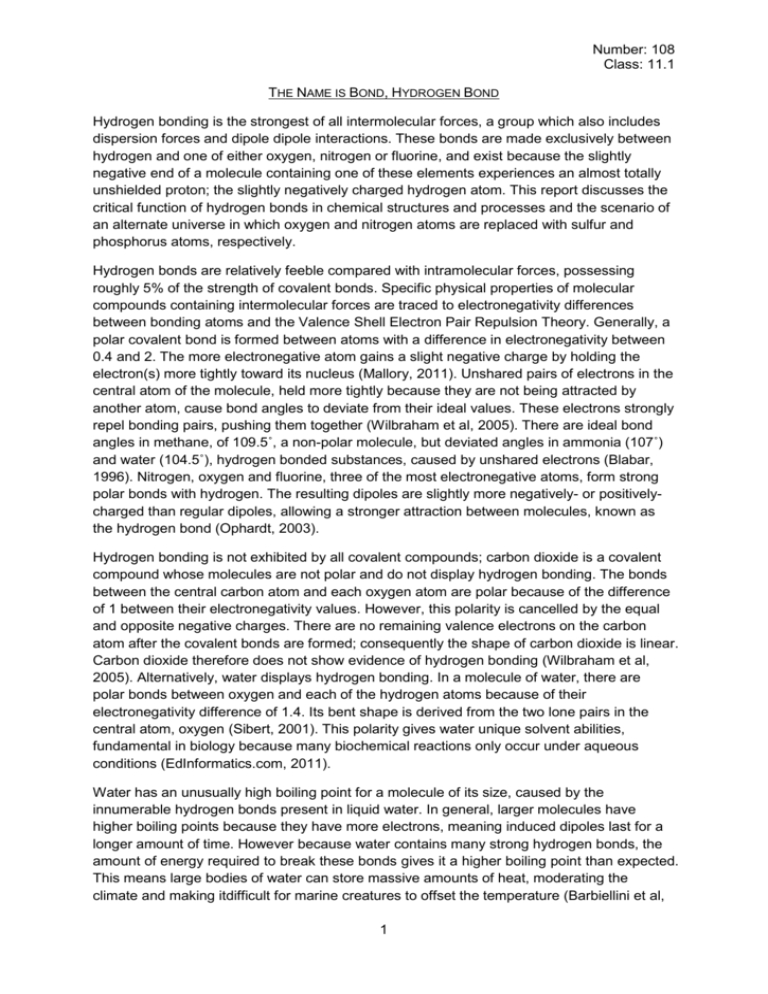
Number: 108
Class: 11.1
THE NAME IS BOND, HYDROGEN BOND
Hydrogen bonding is the strongest of all intermolecular forces, a group which also includes
dispersion forces and dipole dipole interactions. These bonds are made exclusively between
hydrogen and one of either oxygen, nitrogen or fluorine, and exist because the slightly
negative end of a molecule containing one of these elements experiences an almost totally
unshielded proton; the slightly negatively charged hydrogen atom. This report discusses the
critical function of hydrogen bonds in chemical structures and processes and the scenario of
an alternate universe in which oxygen and nitrogen atoms are replaced with sulfur and
phosphorus atoms, respectively.
Hydrogen bonds are relatively feeble compared with intramolecular forces, possessing
roughly 5% of the strength of covalent bonds. Specific physical properties of molecular
compounds containing intermolecular forces are traced to electronegativity differences
between bonding atoms and the Valence Shell Electron Pair Repulsion Theory. Generally, a
polar covalent bond is formed between atoms with a difference in electronegativity between
0.4 and 2. The more electronegative atom gains a slight negative charge by holding the
electron(s) more tightly toward its nucleus (Mallory, 2011). Unshared pairs of electrons in the
central atom of the molecule, held more tightly because they are not being attracted by
another atom, cause bond angles to deviate from their ideal values. These electrons strongly
repel bonding pairs, pushing them together (Wilbraham et al, 2005). There are ideal bond
angles in methane, of 109.5˚, a non-polar molecule, but deviated angles in ammonia (107˚)
and water (104.5˚), hydrogen bonded substances, caused by unshared electrons (Blabar,
1996). Nitrogen, oxygen and fluorine, three of the most electronegative atoms, form strong
polar bonds with hydrogen. The resulting dipoles are slightly more negatively- or positivelycharged than regular dipoles, allowing a stronger attraction between molecules, known as
the hydrogen bond (Ophardt, 2003).
Hydrogen bonding is not exhibited by all covalent compounds; carbon dioxide is a covalent
compound whose molecules are not polar and do not display hydrogen bonding. The bonds
between the central carbon atom and each oxygen atom are polar because of the difference
of 1 between their electronegativity values. However, this polarity is cancelled by the equal
and opposite negative charges. There are no remaining valence electrons on the carbon
atom after the covalent bonds are formed; consequently the shape of carbon dioxide is linear.
Carbon dioxide therefore does not show evidence of hydrogen bonding (Wilbraham et al,
2005). Alternatively, water displays hydrogen bonding. In a molecule of water, there are
polar bonds between oxygen and each of the hydrogen atoms because of their
electronegativity difference of 1.4. Its bent shape is derived from the two lone pairs in the
central atom, oxygen (Sibert, 2001). This polarity gives water unique solvent abilities,
fundamental in biology because many biochemical reactions only occur under aqueous
conditions (EdInformatics.com, 2011).
Water has an unusually high boiling point for a molecule of its size, caused by the
innumerable hydrogen bonds present in liquid water. In general, larger molecules have
higher boiling points because they have more electrons, meaning induced dipoles last for a
longer amount of time. However because water contains many strong hydrogen bonds, the
amount of energy required to break these bonds gives it a higher boiling point than expected.
This means large bodies of water can store massive amounts of heat, moderating the
climate and making itdifficult for marine creatures to offset the temperature (Barbiellini et al,
1
Number: 108
Class: 11.1
1999; Clark, 2000). Water molecules freeze in a crystal lattice. More stable hydrogen bonds
holding the molecules rigidly apart result in a less dense frozen state of water. Ponds can
freeze over during winter while sustaining a habitat for marine creatures below, rather than
ice sinking to the bottom, never to melt or return to the surface (Wollard, 2006). Water has a
surface tension which is higher than that of most liquids. In a droplet of water, the molecules
are unable to form hydrogen bonds with the surrounding air, so they are drawn toward the
center of the liquid to produce surface tension (Wilbraham et al, 2005).
Hydrogen bonds occur in important biological molecules including deoxyribonucleic acid
(DNA), ribonucleic acid (RNA) and proteins. In DNA complementary pairing of nitrogen
bases adenine and thymine is held together with two hydrogen bonds and the pairing of
cytosine and guanine is held with three, shown in Figure 1 with dotted lines. These hydrogen
bonds help to stabilise DNA (Bright Hub Inc., 2011), and while maintaining the double helix
shape of DNA, are weak enough to be broken in replication and transcription (Abrams, 2008).
RNA is a single strand of nucleic acid corresponding to a gene, formed from DNA. In a cell,
RNA travels from the nucleus to a ribosome where nitrogen bases are decoded in order to
attract specific amino acids. This forms a protein. Alpha helices and beta pleated sheets,
secondary structures of proteins, require hydrogen bonds to pull them into the correct
shapes, essential for the function of a particular protein (Evans, 2011).
Figure 1: Hydrogen Bonds Between Nitrogen Bases in DNA (Harvard College, 2007)
Replacing oxygen with sulfur and nitrogen with phosphorus would create a remarkably
different universe. Sulfur shows marked differences from oxygen, despite their sharing a
group, as phosphorus does from nitrogen. Oxygen and sulfur have similar electron
configurations and form similar covalent compounds (Flinn, n.d.). Sulfur has difficulty coming
close to other atoms because of its size – almost 60% larger than oxygen – so forms weak
double covalent bonds (Purdue University, 2004). Its electronegativity of 2.5, 1 lower than
oxygen’s, shows sulfur would form polar covalent bonds with hydrogen, though they would
be very weak. Hydrogen sulfide, which would replace water, would not possess water’s
unique qualities, despite having a similar molecular geometry (Flinn, n.d.). Oxygen and sulfur
have the same number of valence electrons, so when two bonds are formed with hydrogen
atoms, they each have two lone pairs of electrons. In hydrogen sulfide the bond angle
between bonding pairs is smaller than in water, at 92.2°. Hydrogen sulfide molecules are not
as polar as water molecules so display comparatively weak intermolecular forces. In the
absence of hydrogen bonding, hydrogen sulfide boils at -60.7 degrees Celsius. This trend is
continued when group six elements bond with hydrogen atoms, shown in Figure 2. This
trend is similar in groups 4, 5 and 7. (Goyal, 2009).
2
Number: 108
Class: 11.1
Figure 2: Comparative Boiling Points of Molecules Containing Hydrogen (Goyal, 2009)
Whilst nitrogen is virtually inert at room temperature, phosphorus can spontaneously burst
into flames when exposed to air (Chemsoc, 2010; Gagnon, n.d.). Phosphorus has a
comparable electron configuration to nitrogen, however, like in the case of sulfur and oxygen,
phosphorus has a lower electronegativity than nitrogen, and would form non-polar covalent
bonds with hydrogen due to an electronegativity difference of 0.1 (‘Electronegativity Values
of Elements’, 2011). In DNA, following the substitution of nitrogen for phosphorus atoms, the
covalent bonds between hydrogen and phosphorus would be non-polar, and hydrogen
bonds between uncharged molecules would not occur. This would mean DNA would not be
able to exist as a double helix, because no hydrogen bonds would be present to hold
‘nitrogen’ bases together. Without DNA, RNA would not exist or be decoded for the
production of proteins. However, supposing proteins could be formed, they would not
assume the secondary structures of alpha helices and beta pleated sheets. This can be
seen in Figure 3, a diagrammatic representation of an alpha helix; the covalent bonds
between nitrogen and hydrogen would be non-polar when formed between phosphorus and
hydrogen, which would also be seen in beta pleated sheets (Kaiser, 2005). Hydrogen bonds
would not be formed between the non-polar molecules, thus the secondary structures of
proteins would be unable to form and the protein would lose its function.
3
Number: 108
Class: 11.1
Figure 3: Diagram Showing Hydrogen Bonds in Alpha Helix Structure and Covalent Bonds
Between Nitrogen and Hydrogen (Kaiser, 2005)
Life observed on Earth would not exist in its current form in the alternative universe. Without
oxygen and nitrogen, all known life forms, dependent on molecules containing these
elements, would not possibly be able to exist. Hydrogen sulfide, without the unique qualities
of water, would not assume the same role in nature as water does in this universe. For
hydrogen sulfide to take on its liquid state, so as to take on the role of oceans, the planet on
which the alternate universe is set would have to be very cold. In a universe such as this,
where the most important substance for life, water, does not exist, and DNA, RNA and
proteins do not exist, it is reasonable to hypothesise that life could exist, evolved differently
from life on Earth. In some prokaryotic cells, there have been observations of sulfur being
used for metabolism rather than oxygen. Of particular interest are sulfur-reducing bacteria,
which reduce elemental sulfur (S8) to hydrogen sulfide (as opposed to sulfate-reducing
bacteria, as sulfate contains oxygen). Whilst these cells would still contain biological
structures such as DNA and proteins, which contain hydrogen bonding, they are able to give
an indication of life which may exist outside the realms of life seen on Earth. Notably, since
fluorine would be retained in the alternate universe, hydrogen bonding between molecules of
a substance such as hydrogen fluorine would still be present.
Conclusion – restate points and extrapolate or something.
A world without hydrogen bonding would be significantly different from the Earth we know,
and the concept of life developed differently from life as it is known here is difficult to grasp.
This report has considered the subtle importance of hydrogen bonding and how an alternate
4
Number: 108
Class: 11.1
universe may exist without oxygen and nitrogen in compounds, replaced by sulfur and
phosphorus respectively. This idea could aid in the expansion of the search for life
elsewhere in the known universe, with the understanding that it may not resemble life on
Earth in many ways.
http://www.reef.edu.au/asp_pages/secb.asp?FormNo=2
http://www.newton.dep.anl.gov/askasci/chem03/chem03447.htm
http://student.ccbcmd.edu/~gkaiser/biotutorials/proteins/fg4a.html
http://www.chemguide.co.uk/atoms/bonding/vdw.html
http://education.jlab.org/itselemental/ele015.html
Maybe used
http://mattson.creighton.edu/H2S/H2S_Info.html
5
Number: 108
Class: 11.1
Sources
Abrams, J. (2008). DNA Replication and Transcription. Retrieved May 29th, 2011, from
http://www.postmodern.com/~jka/rnaworld/rna/index.html
Barbiellini, B., Hamann, D.R., Isaacs, E.D., Platzman, P.M., Shukla, A. & Tulk, C.A. (1999).
The Secret Nature of Hydrogen Bonds. Retrieved May 12th, 2011, from
http://swift.cmbi.ru.nl/teach/B2/HTML/hbonds.html
Blabar, M. (1996). Molecular Geometry and Bonding Theories. Retrieved May 22nd, 2011,
from
http://www.mikeblaber.org/oldwine/chm1045/notes/Geometry/VSEPR/Geom02.htm
Bright Hub Inc. (2011). DNA Structure: The Importance of Hydrogen Bonds. Retrieved May
24th, 2011, from http://www.brighthub.com/science/genetics/articles/23384.aspx
Chemsoc. (2010). Visual Elements: Group 15. Retrieved May 22nd, 2011, from
http://www.rsc.org/chemsoc/visualelements/pages/data/intro_groupv_data.html
EdInformatics.com. (1999). Why Is Water Such a Good Solvent ? Retrieved May 28th, 2011,
from http://www.edinformatics.com/interactive_molecules/water.htm
Electronegativity Values of Elements. (2011). Retrieved May 22nd, 2011, from
http://www.green-planet-solar-energy.com/electronegativity-values.html
Evans, D. (2011). The Formation of Hydrogen Bonds. Retrieved May 29th, 2011, from
http://www.ehow.com/about_6462286_formation-hydrogen-bonds.html
Flinn, C. (n.d.) Descriptive Chemistry Intersession. Retrieved May 22nd, 2011, from
http://www.chem.mun.ca/homes/pmhome/peter/Thirdmidtermdescriptive.pdf
Goyal, L.D. (2009). Supplemental Topics: Hydrogen Bonding. Retrieved May 22nd, 2011,
from http://www.colgworld.com/intermolecular.html
Harvard College. (2007). Nucleotides and the Double Helix. Retrieved May 25th, 2011, from
http://cyberbridge.mcb.harvard.edu/dna_1.html
Kaiser, G.E. (2005). Secondary Structure of a Protein. Retrieved June 1st, 2011, from
http://student.ccbcmd.edu/~gkaiser/biotutorials/proteins/fg4a.html
Mallory, C. (2011). Professor Mallory. Retrieved May 12th, 2011, from
http://themalloryfamily.net/Chemistry/Chemistry%2051L/Handouts/Chemical%20Bondi
ng%20and%20Molecular%20Polarity.pdf
Ophardt, C.E. (2003). Hydrogen Bonds. Retrieved May 11th, 2011, from
http://www.elmhurst.edu/~chm/vchembook/161Ahydrogenbond.html
Purdue University. (2004). Bodner Research Web. Retrieved May 15th, 2011, from
http://chemed.chem.purdue.edu/genchem/topicreview/bp/ch10/group6.php
Sibert, G. (2001). ACT Laboratory. Retrieved May 12th, 2011, from
http://www.files.chem.vt.edu/RVGS/ACT/lab/ACT-lab.html
6
Number: 108
Class: 11.1
Wilbraham, A.C., Staley, D.D., Matta, M.S. & Waterman, E.L. (2005). Prentice Hall
Chemistry. Massachusetts: Pearson Prentice Hall.
Wollard, K. (2006). Why Does Water Expand When It Cools ? Retrieved May 15th, 2011,
from http://www.word-detective.com/howcome/waterexpand.html
7





